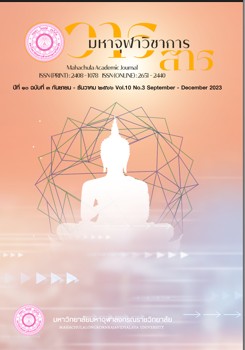Guidelines for Applying the Abhisamãcãra Principle to Promote the Etiquette of Thai Monks
Main Article Content
Abstract
This research has three objectives: (1) to study the current state of Thai monks’ etiquette, (2) to study the Abhisamãcãra in Theravada Buddhist scriptures, and (3) to study the application of the Abhisamãcãra principle to promote Thai monks’ etiquette. This research employed qualitative research methodology by studying documents and interviewing 9 key informants, analyzing its content and then presenting the report in a descriptive manner.
The findings show that: (1) the state of etiquette in the use of communication tools and technology in terms of the nature of use in conjunction with work communication public relations searching for information, (2) the state of etiquette for one's conduct in public on issues of alms-gathering, dressing, standing, walking, sitting and conducting oneself in public places, and (3) the state of etiquette that one did not study etiquette before ordination on the issue of traditional ordination values. Under the improper learning of the discipline before ordination and laxity in the temple's regulations, if the positive effect is taken into consideration, it gave rise to the effectiveness in the Buddhist works whereby it facilitates the convenient communication and receiving information as the good tools in making public relation between individuals and it also serves as the communicative tools to outside people, if the negative effect in taken into account, it gave rise to the wide image and faith of people toward Buddhist monks and Buddhism even reflecting on the guardian and affiliation temples. From the study of the Abhisamãcãra of Buddhist monks, it showed that the Buddha has prescribed the precepts that the monks should follow which include etiquette in dressing in perimeter, showing respect, alms-giving, eating food, talking, standing, walking, sitting and behaving in public where one should control their body, speech and mind for the beautiful manners to be venerated by people in a society. In order to be used as a guideline for applying Abhisamãcãra to promote the etiquette of Thai Buddhist monks at the personal level, the first step is to consider the purpose of communication and information retrieval whereby considering the interests of oneself, the Sangha and Buddhism should be done by putting the principle of moral shame and dread into action. In doing this, one should create awareness of the representation of the Buddha by making awareness in developing the research and virtues to be followed, one should understand time and place where etiquette could be properly realized. In the policy level, one should bring in Abhisamãcãra to practice by preparing a manual on the etiquette of Thai Buddhist monks. The social expectation toward Buddhist monks should be emphasized through training on etiquette since the family level till educational institution and thereby becoming the Buddhist monks in order to continue Buddhism. Once done, Buddhism could be sustained as long as possible.
Article Details

This work is licensed under a Creative Commons Attribution-NonCommercial-NoDerivatives 4.0 International License.
References
เฉลิมศรี พรายพงษา. “มารยาทไทย: วัฒนธรรมบนรากฐานของพระพุทธศาสนา”. ปริญญานิพนธ์ศิลป ศาสตรมหาบัณฑิต. มหาวิทยาลัยราชภัฏธนบุรี, ๒๕๔๕.
ประมาณเลิศ อัจฉริยปัญญากุล. “การพัฒนาวิธีการพิจารณาอธิกรณ์พระสงฆ์กระทำผิดพระวินัยเป็นรูปแบบศาลวินัยสงฆ์และพระสังฆาธิการกระทำผิดทางปกครองสงฆ์ เป็นรูปแบบศาลปกครองสงฆ์”. รายงานการวิจัย. คณะสังคมศาสตร์: มหาวิทยาลัยมหาจุฬาลงกรณราชวิทยาลัย, ๒๕๖๐.
พระครูสาครสุทธิธรรม (ดิลก กิตฺติติลโก) และคณะ. “สิกขาบทของพระพุทธศาสนาเถรวาทกับมหายาน”. วารสาร มจร ปรัชญาปริทรรศน์. ปีที่ ๒ ฉบับที่ ๒ (กรกฎาคม-ธันวาคม ๒๕๖๒) : ๑๑๕.
พระธรรมปิฎก (ป. อ. ปยุตฺโต). พจนานุกรมพุทธศาสน์ ฉบับประมวลศัพท์. พิมพ์ครั้งที่ ๑๑. กรุงเทพมหานคร: มหาวิทยาลัยมหาจุฬาลงกรณราชวิทยาลัย, ๒๕๔๖.
พระปลัดนอบ รกฺขิตสีโล. คู่มือวิทยากรอบรมคุณธรรม “ค่ายพุทธบุตร”. กรุงเทพมหานคร: บริษัทพิมพ์ดี จำกัด, ๒๕๓๖.
พระมหาสมชาย บัวแก้ว และคณะ. “อภิสมาจาร: กระบวนการพัฒนาบุคลิกภาพตามแนวพระพุทธศาสนา”. วารสารศิลปะการจัดการ. ปีที่ ๕ ฉบับที่ ๓ (กันยายน-ธันวาคม ๒๕๖๔) : ๙๐๐-๙๐๑.
พระมหาอำนาจ อจฺฉริยเมธี (ดีรัตน์). “ความรับผิดทางอาญาและพระธรรมวินัยของภิกษุสงฆ์: กรณีศึกษาพระภิกษุรับของโจร”. สารนิพนธ์นิติศาสตรมหาบัณฑิต. บัณฑิตวิทยาลัย: มหาวิทยาลัยมหาจุฬาลงกรณราชวิทยาลัย, ๒๕๖๕.
พระวันชัย ภูริทตฺโต (อนนตรี). “การศึกษาเชิงวิเคราะห์มูลเหตุของผู้เป็นต้นบัญญัติสิกขาบทในพระไตรปิฎกกับมูลเหตุแห่งการละเมิดพระวินัยของพระสงฆ์ไทยในปัจจุบัน”. วิทยานิพนธ์ ศาสนศาสตรมหาบัณฑิต สาขาพุทธศาสนาและปรัชญา. บัณฑิตวิทยาลัย: มหาวิทยาลัยมหามกุฏราชวิทยาลัย, ๒๕๕๒.
พระอธิการสมบัตร จารุธมฺโม (ถาวร). “การศึกษาเปรียบเทียบลักษณะของอภิสมาจารสิกขาบทของพระภิกษุในพระพุทธศาสนานิกายเถรวาทและมหายาน”. วิทยานิพนธ์พุทธศาสตรมหาบัณฑิต. บัณฑิตวิทยาลัย: มหาวิทยาลัยมหาจุฬาลงกรณราชวิทยาลัย, ๒๕๖๒.
พระอภินันท์ เหมโก (ตีทอง). “การศึกษาวิเคราะห์สิกขาบทที่เป็นโลกวัชชะและปัณณัติวัชชะในภิกษุปาฏิโมกข์”. วิทยานิพนธ์พุทธศาสนามหาบัณฑิต. บัณฑิตวิทยาลัย: มหาวิทยาลัยมหาจุฬาลงกรณราชวิทยาลัย, ๒๕๕๑.
พิธพิบูลย์ กาญจนพิพิธ และคณะ. “การศึกษาวิถีชีวิตของสามเณรในวัดเขตกรุงเทพมหานคร”. รายงานการวิจัย. คณะครุศาสตร์: มหาวิทยาลัยมหาจุฬาลงกรณราชวิทยาลัย, ๒๕๕๓.
ภารดี พูลประภา เอี่ยมเจริญ. “รูปแบบการแก้ไขวิกฤติศรัทธาในพระสงฆ์ตามหลักพระวินัย”. วารสารวิทยาลัยสงฆ์นครลำปาง. ปีที่ ๗ ฉบับที่ ๑ (มกราคม-มิถุนายน ๒๕๖๑) : ๒๕.
มหาจุฬาลงกรณราชวิทยาลัย. พระไตรปิฎกภาษาไทย ฉบับมหาจุฬาลงกรณราชวิทยาลัย. กรุงเทพมหานคร: โรงพิมพ์มหาจุฬาลงกรณราชวิทยาลัย, ๒๕๓๙.
ราชบัณฑิตยสถาน. พจนานุกรม ฉบับราชบัณฑิตยสถาน. พิมพ์ครั้งที่ ๒. กรุงเทพมหานคร: อักษรเจริญทัศน์, ๒๕๕๔.
ศิริโรจน์ นามเสนา. “อภิสมาจารในพระวินัยปิฎกกับการเผยแผ่ของพระสงฆ์”. วิทยานิพนธ์พุทธศาสตรดุษฎีบัณฑิต. บัณฑิตวิทยาลัย: มหาวิทยาลัยมหาจุฬาลงกรณราชวิทยาลัย, ๒๕๕๘.
สมศรี สุกมลนันท์. มารยาทสังคม. กรุงเทพมหานคร: บริษัทปูนซิเมนต์ไทย จำกัด, ๒๕๓๕.
อัญชลี ปิยปัญญาวงศ์ และคณะ. “การพัฒนาสมณสารูปของพระภิกษุในบริบทสังคมไทย”. วารสาร มจร สังคมศาสตร์ปริทรรศน์. ปีที่ ๑๑ ฉบับที่ ๕ (กันยายน-ตุลาคม ๒๕๖๕) : ๓๔๕-๓๔๖.
โชว์ข่าวเช้านี้. “แชทหลุดพระนักเทศน์ ทักคุยกับ ด.ญ.เชิงชู้สาว”. [ออนไลน์]. แหล่งที่มา: https://www.pptvhd๓๖.com/news [๒๓ มกราคม ๒๕๖๖].
ไทยรัฐออนไลน์. “พบหลวงพี่นักโบก นั่งข้างถนนเรียกรถหยุด ขายวัตถุมงคล โกยเงินเข้ากระเป๋า”. [ออนไลน์]. แหล่งที่มา: https://www.thairath.co.th/news/society/1864731 [๒๓ มกราคม ๒๕๖๖].
มติชนออนไลน์. ศาสนา-วัฒนธรรม. “พระสงฆ์ทะเลาะวิวาททำร้ายร่างกายเหตุจากแย่งพื้นที่บิณฑบาต”. [ออนไลน์]. แหล่งที่มา: https://www.matichon.co.th/religious-cultural [๒๓ มกราคม ๒๕๖๖].


